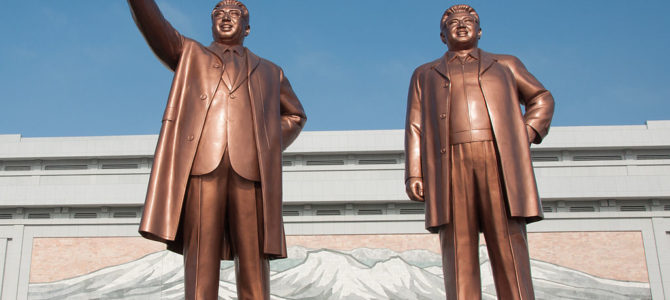
On September 3, at exactly noon local time, North Korea detonated its sixth nuclear device purportedly releasing 140 kilotons of TNT equivalent, according to a recent U.S. intelligence estimate, and almost ten times greater than the U.S. nuclear bomb dropped on Hiroshima in August 1945.
Shortly after the detonation, which triggered an artificial magnitude 6.3 earthquake, North Korea claimed that it successfully tested a thermonuclear bomb design that can be fitted on the Hwasong-14/KN20 intercontinental-range ballistic missile (ICBM), which was first tested on July 4 and is likely capable of reaching the continental United States.
While the test of a hydrogen bomb has been expected by North Korea analysts for some time, it has nonetheless triggered a nuclear war-scare in the United States fueled by the media and accentuated by repeated threats of the American president to preemptively strike North Korean missile sites.
However, while the situation remains tense and may of course escalate quickly, current events on the Korean Peninsula point more to Friedrich Nietzsche’s concept of the “eternal recurrence of the same thing” than Friedrich Hegel’s “slaughter benches of history.” In other words, despite North Korea’s burgeoning nuclear capabilities, there is no indication that the current situation is much different from past crises, all of which subsided without (much) bloodshed.
Deterrence Has Been Working
The reason we have not seen warfare on the Korean Peninsula in more than seven decades is because deterrence works, despite U.S. National Security Advisor H.R. McMaster’s recent assertion that “classical deterrence theory” does not apply to North Korea. South Korea (with the help of the United States) and North Korea can destroy one another. It is this mutual hostage situation that has kept the peace on the peninsula.
In fact, North Korea’s nuclear ballistic missile program—along with North Korean biological, chemical, and conventional warfare capabilities—is part of its deterrence strategy vis-à-vis South Korea and its allies. It is meant to deter a joint U.S.-South Korean attack on the North and prevent a toppling of the Kim Jong-Un regime. (Kim Jong-Un’s thinking is likely inspired by the fate of Muammar-al-Qaddafi and Saddam Hussein, who both gave up their nuclear weapons programs only to be overthrown and killed.)
In addition, shorter range nuclear-armed ballistic missiles and ICBMs are also useful for North Korea in the event of an actual war with South Korea and the United States. Carefully hidden short- and middle-range nuclear-armed ballistic missiles can slow down a joint U.S.-South Korean invasion force and attack South Korean, U.S., and Japanese military installations. ICBMs held in reserve and aimed at U.S. cities—should the United States not succeed destroying them at the outset of the war—can deter the United States from rushing in reinforcements and launch nuclear counterstrikes, as well prevent the allies from deposing the regime.
In turn, the United States has built up its deterrence strategy vis-à-vis North Korea by threatening massive retaliation in the event of a direct nuclear attack on the continental United States and South Korea, which would spell the end of the communist dictatorship. South Korea has also deployed precision-strike-capable missiles and special operations forces to be launched and dispatched against Kim Jong-un and the North’s military leadership in the event of a nuclear first strike or if there is an indication that an attack is imminent.
Deterrence Works If Everyone Doesn’t Want War
As I have argued in The Diplomat, for deterrence to work, South Korea, North Korea, and the United States need to share common assumptions about military and political realities on the Korean Peninsula, the most important of which is that war of any kind will be a catastrophe that would leave all three sides in a much worse position. Despite hyperbolic statements by the Trump White House and Pyongyang, this mutual assumption appears to still hold true, underwritten by repeated statements that the United States and North Korea would use nuclear weapons only in retaliation for a preemptive nuclear strike first carried out by the other side.
Mutual suspicions surrounding a sneak attack remain, of course. For example, North Korea has repeatedly condemned B-1B Lancer heavy strategic bomber patrols over and off the Korean Peninsula. Although the B-1B can no longer carry nuclear weapons, Pyongyang continues to see it as a nuclear-capable platform for launching a surprise nuclear attack. It remains also deeply suspicious of joint U.S.-South Korean military exercises, which it sees as precursors to an actual invasion of North Korea.
Nevertheless, military exercises and occasional flare-ups have been a regular occurrence over the past years and have become partly ritualized. One analyst went as far as to outline a basic plot of any North Korean crisis. The fact of the matter is that some analysts tend to focus too much on North Korean capabilities rather than the country’s likely intentions. A more capable and destructive missile arsenal does not automatically translate into a more aggressive foreign and defense policy. Furthermore, it does not negate the assumption that Kim Jong-Un is primarily driven by regime survival.
Threats Only Make the Situation Worse
Nonetheless, this does not imply that North Korea is not interested in weakening its adversaries in any way it can short of a military confrontation. For example, next to weapons of last resort, the North’s ICBMs are also useful in undermining military cooperation between the United States, South Korea, and Japan. The logic behind this is simple: The United States would probably not risk the destruction of one of its cities by a North Korean thermonuclear bomb in order to defend Seoul or Tokyo. Nuclear strategists refer to this as a “decoupling strategy”: the threat of nuclear attack decouples the United States from its allies in East Asia, although there is no hard evidence that this has indeed been a consideration of U.S. policy makers in the last months.
Unfortunately, however, the Trump administration has amplified the perception of a growing wedge between the United States and its East Asian allies in the last few weeks through various actions and statements. President Trump in essence recently called South Koreans appeasers and announced that the United States would withdraw from a bilateral, five-year-old free trade agreement. Moreover, President Trump’s threat of preventive war is putting pressure on South Korea and Japan to pursue independent military capabilities. This could trigger an accelerated regional arms race and further destabilize the region.
Still, there is no indication that the security situation on the Korean Peninsula has fundamentally changed with the successful test of an advanced nuclear device on September 3 and recent ballistic missile launches. Deterrence remains intact. North Korea has had the capability to inflict severe damage on South Korean and Japanese cities for years, but has not done so because it assumes that it would threaten the survival of the regime. Indeed, supposing that Kim is no madman, his primary intention behind recent tests is to strengthen deterrence and prevent rather than initiate war.
What next steps should the United States then take?
First, given that deterrence continues to work, U.S. talk of preemptive war against North Korea is counterproductive and needs to stop. Second, the United States, in close consultations with its regional allies, needs to continue to reach out to North Korea and leave all diplomatic options open. Third, as one former U.S. diplomat emphasizes, the short-term objective of U.S. diplomacy should be a slowing down or even freeze of the North Korean nuclear weapons and missile programs rather than an unrealistic push for complete denuclearization. Fourth, the United States and North Korea need to agree on concrete steps (e.g. military-to-military talks) to deescalate tensions in the long-run.
Last and most important, the U.S. government needs to speak with one voice on North Korea lest it risk misinterpretation of its moves by all sides with possibly disastrous consequences, not just for the Korean Peninsula but for all of East Asia.









